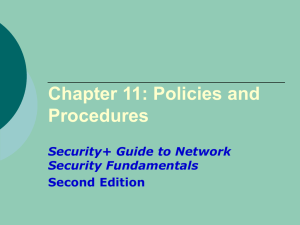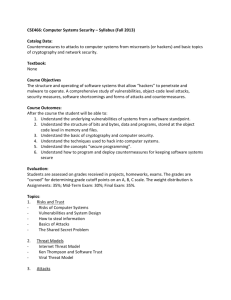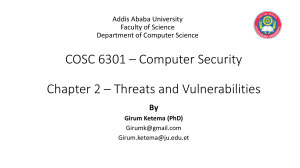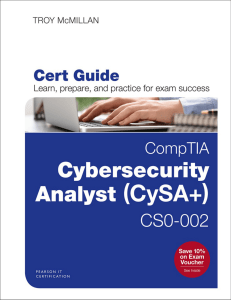Document 12643398
advertisement
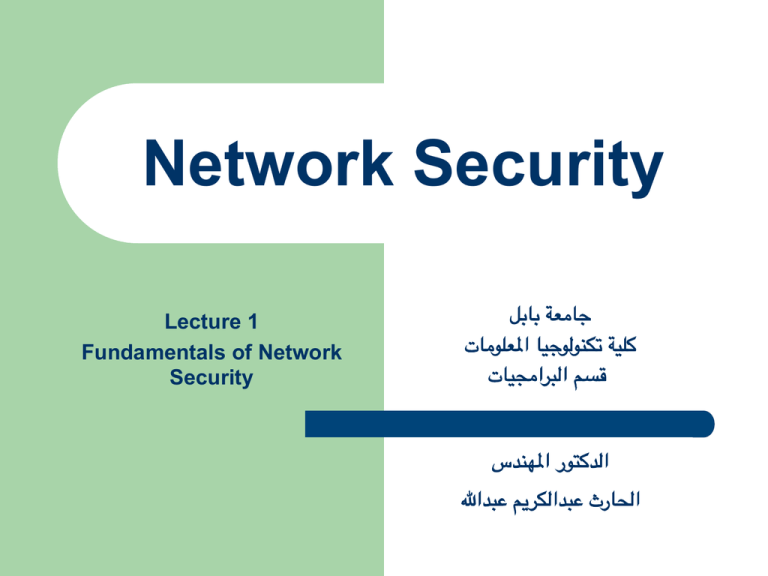
Network Security Lecture 1 Fundamentals of Network Security !"#" $%&#' ت#&)*%+ ا#-').)/01 $-*2 ت#-3&ا45. ا678 س:/;+=)ر ا2:.ا >ا:5? 6@40.ا:5? رث#B.ا What is Security? ! What is Network Security? l National Security Telecommunications and Information Systems Security Committee (NSTISSC) l Network security is the protection of information and systems and hardware that use, store, and transmit that information. l Network security encompasses those steps that are taken to ensure the confidentiality, integrity, and availability of data or resources. Rationale for Network Security Network security initiatives and network security specialists can be found in private and public, large and small companies and organizations. The need for network security and its growth are driven by many factors: 1. 2. 3. 4. 5. 6. Internet connectivity is 24/7 and is worldwide Increase in cyber crime Impact on business and individuals Legislation & liabilities Proliferation of threats Sophistication of threats Goals of a Network Security Program l Confidentiality – l Integrity – l Prevent the detection of sensitive information from unauthorized people, resources, and processes The protection of system information or processes from planned or accidental modification Availability – The assurance that systems and data are accessible by authorized users when needed Risk Management l l l l Risk Analysis Threats Vulnerabilities Countermeasures Risk Management Control physical access Password protection Develop a Security Policy l l The process of measuring and quantifying risk and establishing an acceptable level of risk for the organization Risk can be mitigated, but cannot be eliminated Network Security “Threat” • A potential danger to information or a system • An example: the ability to gain unauthorized access to systems or information in order to commit fraud, network intrusion, industrial espionage, identity theft, or simply to disrupt the system or network • There may be weaknesses that greatly increase the likelihood of a threat manifesting • Threats may include equipment failure, structured attacks, natural disasters, physical attacks, theft, viruses and many other potential events causing danger or damage Types of Network Threats l l l l l Eavesdropping Denial-of-service Packet replay Man-in-the-middle Packet modification Vulnerability • A network vulnerability is a weakness in a system, technology, product or policy • In today’s environment, several organizations track, organize and test these vulnerabilities • The US government has a contract with an organization to track and publish network vulnerabilities • Each vulnerability is given an ID and can be reviewed by network security professionals over the Internet. • The common vulnerability exposure (CVE) list also publishes ways to prevent the vulnerability from being attacked Risk Management Terms l l l l l l Vulnerability – a system, network or device weakness Threat – potential danger posed by a vulnerability Threat Agent – the entity that indentifies a vulnerability and uses it to attack the victim Risk – likelihood of a threat agent taking advantage of a vulnerability and the corresponding business impact Exposure – potential to experience losses from a threat agent Countermeasure – put into place to mitigate the potential risk Understanding Risk Threat Agent Exploits Threat Leads to Vulnerability Risk Directly affects Asset Exposure Causes Countermeasure Can be safeguarded by Can damage Types of Attacks Types of Attack Specific Network Attacks l l l l l l l l l ARP Attack Brute Force Attack Worms Flooding Sniffers Spoofing Redirected Attacks Tunneling Attack Covert Channels Attack Methodology Stages - the methodology of network attacks is well documented and researched. This research has led to greater understanding of network attacks and an entire specialization of engineers that test and protect networks against attacks (Certified Ethical Hackers/ Penetration Testers) Tools - penetration testers have a variety of power tools that are now commercially available. They also have may open source free tools. This proliferation of powerful tools has increased the threat of attack due to the fact that even technical novices can now launch sophisticated attacks. Stages of an Attack l Today’s attackers have a abundance of targets. In fact their greatest challenge is to select the most vulnerable victims. This has resulted in very wellplanned and structured attacks. These attacks have common logistical and strategic stages. These stages include; – Reconnaissance – Scanning (addresses, ports, vulnerabilities) – Gaining access – Maintaining Access – Covering Tracks Tools of the Attacker l The following are a few of the most popular tools used by network attackers: – – – – – – – – Enumeration tools (dumpreg, netview and netuser) Port/address scanners (AngryIP, nmap, Nessus) Vulnerability scanners (Meta Sploit, Core Impact, ISS) Packet Sniffers (Snort, Wire Shark, Air Magnet) Root kits Cryptographic cracking tools (Cain, WepCrack) Malicious codes (worms, Trojan horse, time bombs) System hijack tools (netcat, MetaSploit, Core Impact) Countermeasures l l l l l l l l DMZ/NAT IDS/IPS Content Filtering/NAC Firewalls/proxy services Authentication/Authorization/Accounting Self-defending networks Policies, procedures, standards guidelines Training and awareness Security Administration l l l l l Policies Standards Guidelines Procedures Baselines What Is a Security Policy? l A document that states how an organization plans to protect its tangible and intangible information assets – – – Management instructions indicating a course of action, a guiding principle, or appropriate procedure High-level statements that provide guidance to workers who must make present and future decisions Generalized requirements that must be written down and communicated to others


